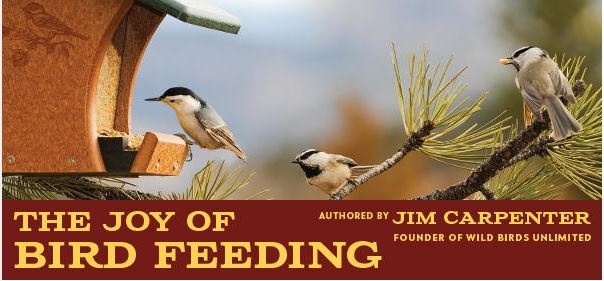5 Steps to Bird Feeding Mastery
Have you thought about the joy and pleasure feeding your birds gives you? The excitement of seeing a new bird in the yard, the anticipation of the arrival of fall and spring migrants (and some sadness when they leave), gives us a measure of joy in our busy lives. Now, Jim Carpenter, founder and owner of Wild Birds Unlimited, Inc. has written a book about The Joy of Bird Feeding. This comprehensive book guides you to a new level of enjoyment of the birds in your yard. It’s a field guide (180 backyard birds from across the country), a how-to for setting up our yards to be bird-friendly, and an education on what birds eat and the differences in bird food quality available on the market. The book is simply chock-full of valuable information we can all use every day to help us enjoy our backyard birds more.

Step 1. The book has 12 chapters. Chapter 1 is about The Five Steps to Bird Feeding Mastery. These are subjects we talk about in the store every day. The first step is to discover what seeds the birds in the yard like to eat. It’s always fun to try new foods (but nothing like bread or mixes that are mostly fillers). You all are past this point, but learning Jim’s approach will help you teach an interested friend or neighbor how to start feeding birds. A mix of quality foods and an old plant saucer may be all that is needed to get someone started.
Step 2 is to increase the offerings. Trying suet dough (fat) products, fruits, and nut mixes increases the types of foods that the birds can choose. More fun though, is that an assortment of foods will ultimately increase the different birds that will come to your yard. Most of these foods come in a variety of “formats” such as loose seed, seed cakes and cylinders, suet cakes, cylinders, nuggets, and spreadable products.
Step 3 is to consider the 12 Elements of a Thoughtful Bird Feeding Station. Soon, you will see blue, numbered circles on products throughout the store. The numbers (1-12) relate to each of the elements-types of feeders, water, perching locations, specialty feeders, critter solutions, etc. We’ll present more on the 12 elements here in the coming months.
Over the past 3-4 years, many of you have started to address Step 4, which is to re-landscape your yards with native plants. As these plants grow and mature, and with the addition of more foods, your yard becomes more attractive to a wider variety of birds. The book describes many considerations for you to evaluate as you design your yard and select your plant palette. A well-designed yard becomes a home for many resident birds, and an upscale “bird hotel” for birds passing through on migration. When laying out the yard, remember the four elements of any good habitat: Food, Water, Shelter and a place to Raise Young.
Step 5 brings us to year around bird feeding. Throughout the year, the birds’ needs can change, and the birds in your yard will change. Becoming seasonally savvy is important when planning your feeder and food purchases. Two quick examples: Increase the amount of fats offered in the fall and winter, so birds are better prepared to deal with the cooler, wet weather of the season. Have a protected ground feeder to put out in the fall to feed the White-crowned sparrows. We can help you with these decisions when you come into the store to make your purchases.
The Joy of Bird Feeding is available in the store now. Makes a great gift for the nature lovers in your life.
EnJOY (!) your birds.

